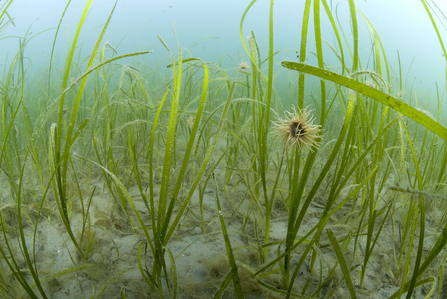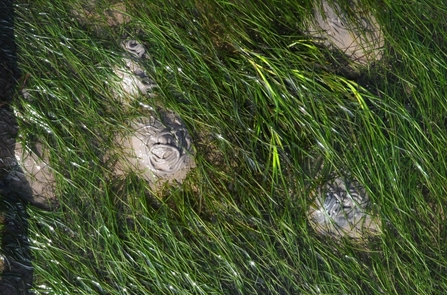
Healthy seagrass beds are great carbon stores © Paul Naylor
Join by 30 January to get 3 months free membership!

Healthy seagrass beds are great carbon stores © Paul Naylor
We strongly support the call to governments across the UK to strengthen protections for these valuable blue carbon stores – including in Marine Protected Areas.Georgia de Jong CleyndertHead of Marine, Cumbria Wildlife Trust
A landmark report published today by a coalition of nature charities provides the first estimate of the carbon stored in seabed habitats in the Irish Sea and along the Welsh Coast.
The report is part of The Blue Carbon Mapping Project, completed by the Scottish Association for Marine Science (SAMS) on behalf of WWF-UK, The Wildlife Trusts and the RSPB. The series of reports mean the UK is the first nation to map and estimate the amount of carbon stored in its seabed habitats, including within Marine Protected Areas (MPAs).
The report reveals that 15.7 million tonnes of organic carbon* are stored in just the top 10cm of seabed sediments – principally made of mud – in the Irish Sea and Welsh Coastal Region.
The Irish Sea and Welsh Coastal Region covers 43,112 square kilometres. This vast area is host to habitats that capture and store carbon, known as ‘blue carbon’. They include seabed sediments (made of mud, silt and sand), vegetated habitats (seagrass meadows, saltmarshes, kelp forests and intertidal seaweeds), maerl beds and biogenic reefs, such as mussel beds and honeycomb worm reefs.
Carbon is primarily absorbed by phytoplankton, which drift to the bottom of the sea when they die and are added to seabed sediment. The research analysed the storage capacity of just the top 10cm of sediment. Some sediments are hundreds of metres thick and contain millennia’s worth of carbon, so the total carbon stored will be far greater.
The Blue Carbon Mapping Project highlights how physical disturbances to the seabed, including from human activity such as bottom trawling, as well as moorings and offshore developments, pose threats to blue carbon stores. Disturbing seabed habitats can release large amounts of carbon into the atmosphere, worsening climate change.
WWF, The Wildlife Trusts, and the RSPB are calling on governments across the UK to strengthen protections for valuable blue carbon stores – including in MPAs – by minimising the impacts of human activities on the seabed. Most MPAs were not designated to protect blue carbon, and failing to protect these areas from disturbance could threaten climate and biodiversity goals – including net-zero and protecting 30% of seas by 2030.
WWF, The Wildlife Trusts & RSPB call for:
Better management of MPAs
Improved strategic planning of activities in UK seas
More investment and research on protecting blue carbon
*Please note that organic carbon should not be converted into carbon dioxide equivalent in this instance due to the complex interaction of atmospheric carbon and the ocean.

Surveying seagrass © Cumbria Wildlife Trust
Head of Marine at Cumbria Wildlife Trust, Georgia de Jong Cleyndert says:
“This key report shows the huge value of our Irish Sea seabeds and demonstrates why they need protection from damaging activities. We strongly support the call to governments across the UK to strengthen protections for these valuable blue carbon stores – including in Marine Protected Areas.
“Along with saltmarshes, seagrass beds do a particularly good job in capturing and storing carbon. While saltmarshes and seagrass beds occupy only 5% of our coastal habitats, they store 13% of the organic carbon – over 420,000 tonnes. Coastal vegetated habitats in the region accumulate up to 250,000 tonnes of carbon per year (18% of the total). That’s a staggering amount!
“Sadly, the UK has lost 90% of seagrass beds over the last century and in Morecambe Bay, around 70% has been lost. Recent surveys show that around 70ha (127 acres) of seagrass remains in the Walney Channel - that’s around the size of 63 football pitches. But there should be much more!
“Here in Cumbria we’re working on an exciting project to restore some of these important seagrass beds in the Walney Channel near Barrow, thanks to funding from Ozone and the Environment Agency. We’re currently carrying out baseline studies of seagrass beds in the region, surveying their size and condition, in collaboration with universities across the North West.
“We’re starting restoration trials on the seagrass beds, to bring them back to their former size and health so they can thrive, along with the species that rely on them. We’re building a store for seagrass seed at South Walney Nature Reserve and training Marine Champions to help monitor and protect the seagrass beds and wider marine environment.
“Our surveying has included sending underwater video cameras onto the seagrass beds with Lancaster University students, and we’ve had help from Cumbria Canoeists and Lakeland Canoe Club to collect some water samples for environmental DNA analysis. We’re also working with Manchester Metropolitan University who are analysing the carbon content of the seagrass beds.
“A really exciting next step of the project is happening this week: with the help of some volunteers we’re about to collect seagrass seeds from healthy seagrass meadows, to plant in areas which need help, which involves lying in mud on a bodyboard! While this can be fun, if muddy work, the underlying message is serious: we must restore and protect these important seabed carbon stores.”

70% of Morecambe Bay's seagrass beds have been lost © Natural England
Blue carbon, as defined in our report, is the term used for carbon captured and/or stored by the world’s ocean and coastal ecosystems. Marine ecosystems capture carbon and lock it away in seabed sediments, especially in vegetated coastal habitats like saltmarsh and seagrass. Saltmarsh and seagrass beds both capture and store carbon whereas seaweeds and kelp forests capture carbon, a proportion of which is then eroded and transported elsewhere as detritus and subsequently buried in seabed sediments. Biogenic reefs act principally as depositories for carbon from other sources. Carbon stores are vulnerable to a variety of human pressures that can cause them to be disturbed, damaged or removed entirely. This can hinder or eliminate their ability to store and/or capture carbon. Long term carbon storage in the sea relies on protecting habitats from damage. Protections also provide other benefits such as providing nursery grounds for fish.
WWF (Worldwide Fund for Nature) is one of the world’s largest independent conservation organisations, active in nearly 100 countries. Our supporters – more than five million of them – are helping us to restore nature and to tackle the main causes of nature’s decline, particularly the food system and climate change. We’re working to ensure a world with thriving habitats and species, and to change hearts and minds so it becomes unacceptable to overuse our planet’s resources. WWF. For your world. For wildlife, for people, for nature. Find out more about our work, past and present at wwf.org.uk
The Wildlife Trusts are making the world wilder and helping to ensure that nature is part of everyone’s lives. We are a grassroots movement of 46 charities with over 900,000 members and 38,000 volunteers. No matter where you are in Britain, there is a Wildlife Trust inspiring people and saving, protecting and standing up for the natural world. With the support of our members, we care for and restore special places for nature on land and run marine conservation projects and collect vital data on the state of our seas. Every Wildlife Trust works within its local community to inspire people to create a wilder future – from advising thousands of landowners on how to manage their land to benefit wildlife, to connecting hundreds of thousands of school children with nature every year. wildlifetrusts.org
The RSPB is the UK’s largest nature conservation charity, protecting habitats, saving species, and helping to end the nature and climate emergency. For over a century we’ve acted for nature through practical conservation and powerful partnerships, campaigning and influence, and inspiring and empowering millions of people, including almost 1.2 million members. Our network of over 200 nature reserves sits at the heart of our world leading science and conservation delivery. Nature is in crisis, but together we can save it. The Royal Society for the Protection of Birds (RSPB) is a registered charity. In England and Wales, no: 207076. In Scotland, no: SC037654. rspb.org.uk